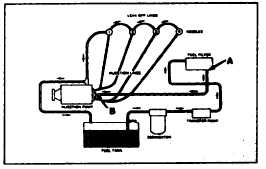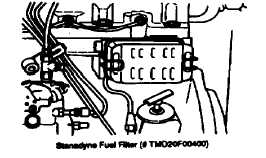| |
TM 10-3930-671-24
Be prepared, with a container, to catch the fuel as it
comes out of the open line. A steady solid stream of fuel
indicates that the fuel pump is probably okay for
continued use. A broken stream with bubbles and
dribbles or no fuel at all indicates the fuel pump is
probably bad or that there are restrictions somewhere in
the fuel circuit. There could also be an air leak in the fuel
pickup line on the suction side of the pump causing the
pump to cavitate.
If restrictions are suspected in the fuel circuit, they are
most likely found to be either plugged fuel filters or trash
on the inlet side of the electric fuel pump.
BLEEDING THE FUEL SYSTEM
Bleeding is necessary on initial installation of the fuel
injection system after any subsequent removal and if the
system should be drained after having run out of fuel.
NOTE
Electrical equipment such as starters
should be shielded with non-conductive
material during the bleeding process to
prevent damage from fuel entry. Also, be
certain that all transmissions, gearboxes,
hydraulic control, etc., are in a neutral
position before attempting to crank the
engine. If a wheel vehicle is involved, be
certain that the wheels are “chocked”
and the parking brake is set.
STANADYNE Fuel System
1.
Turn the ignition switch to the ’ON position.
2.
Loosen the filter outlet connection (A), or the fuel
injection pump inlet connection (B)whichever is
the higher, and allow fuel to flow until free of air.
Tighten the connection.
NOTE
If connection (A) is inaccessible due to
the
type
of
filter
In
use,
loosen
connection (B).
Typical STANADYNE Fuel System Schematic’
3.
Loosen any two injector high-pressure pipe nuts
at the injector end. Set the accelerator to the
fully open position and with the ignition switch
"ON," crank the engine until fuel free from air
flows. Tighten the line nuts.
4.
Start the engine.
FUEL FILTERS
Clean fuel is a must in diesel operation. Extreme
conditions may require additional filters to provide longer
filter change periods--when clean fuel is not available.
Continental diesels are normally equipped with the filter
installed between the fuel injection pump and the transfer
pump outlet-so the filter is on the pressure side of the
transfer pump.
The period for changing the element will largely depend
upon the quality and condition of the fuel available.
Under normal conditions, the element should be
renewed every 400 hours. This period should be
decreased if unavoidable contamination of the fuel is
experienced.
NOTE
Electrical equipment such as staners
should be shielded with non-conduction
material during filter replacing and
priming to prevent fuel entry.
STANADYNE FUEL FILTER
NOTE
This fuel filter is not a water separator. If
water contamination is anticipated, an
additional primary fuel filter and water
separator should be installed before the
fuel transfer pump.
No attempt should be made to clean this type element.
It should be replaced at the regularly scheduled periodic
maintenance interval or if there is reason to believe that it
is plugged. To replace the metal canister element,
simply release the two spring clamps and pull the old
element off the filter bracket. Lube the new element
grommets with clean diesel fuel and push into place.
Snap the spring clamps into position and bleed the fuel
system.
F-152
|



